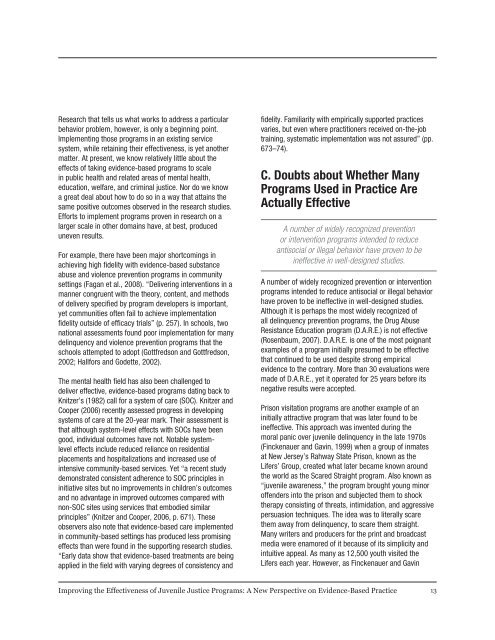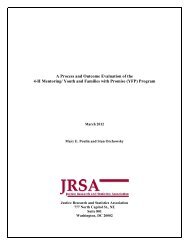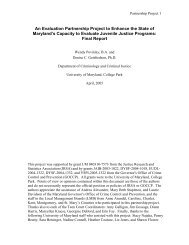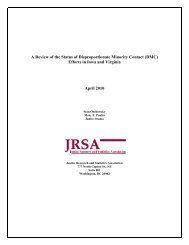Improving the Effectiveness of Juvenile Justice Programs: A New
Improving the Effectiveness of Juvenile Justice Programs: A New
Improving the Effectiveness of Juvenile Justice Programs: A New
Create successful ePaper yourself
Turn your PDF publications into a flip-book with our unique Google optimized e-Paper software.
Research that tells us what works to address a particular<br />
behavior problem, however, is only a beginning point.<br />
Implementing those programs in an existing service<br />
system, while retaining <strong>the</strong>ir effectiveness, is yet ano<strong>the</strong>r<br />
matter. At present, we know relatively little about <strong>the</strong><br />
effects <strong>of</strong> taking evidence-based programs to scale<br />
in public health and related areas <strong>of</strong> mental health,<br />
education, welfare, and criminal justice. Nor do we know<br />
a great deal about how to do so in a way that attains <strong>the</strong><br />
same positive outcomes observed in <strong>the</strong> research studies.<br />
Efforts to implement programs proven in research on a<br />
larger scale in o<strong>the</strong>r domains have, at best, produced<br />
uneven results.<br />
For example, <strong>the</strong>re have been major shortcomings in<br />
achieving high fidelity with evidence-based substance<br />
abuse and violence prevention programs in community<br />
settings (Fagan et al., 2008). “Delivering interventions in a<br />
manner congruent with <strong>the</strong> <strong>the</strong>ory, content, and methods<br />
<strong>of</strong> delivery specified by program developers is important,<br />
yet communities <strong>of</strong>ten fail to achieve implementation<br />
fidelity outside <strong>of</strong> efficacy trials” (p. 257). In schools, two<br />
national assessments found poor implementation for many<br />
delinquency and violence prevention programs that <strong>the</strong><br />
schools attempted to adopt (Gottfredson and Gottfredson,<br />
2002; Hallfors and Godette, 2002).<br />
The mental health field has also been challenged to<br />
deliver effective, evidence-based programs dating back to<br />
Knitzer’s (1982) call for a system <strong>of</strong> care (SOC). Knitzer and<br />
Cooper (2006) recently assessed progress in developing<br />
systems <strong>of</strong> care at <strong>the</strong> 20-year mark. Their assessment is<br />
that although system-level effects with SOCs have been<br />
good, individual outcomes have not. Notable systemlevel<br />
effects include reduced reliance on residential<br />
placements and hospitalizations and increased use <strong>of</strong><br />
intensive community-based services. Yet “a recent study<br />
demonstrated consistent adherence to SOC principles in<br />
initiative sites but no improvements in children’s outcomes<br />
and no advantage in improved outcomes compared with<br />
non-SOC sites using services that embodied similar<br />
principles” (Knitzer and Cooper, 2006, p. 671). These<br />
observers also note that evidence-based care implemented<br />
in community-based settings has produced less promising<br />
effects than were found in <strong>the</strong> supporting research studies.<br />
“Early data show that evidence-based treatments are being<br />
applied in <strong>the</strong> field with varying degrees <strong>of</strong> consistency and<br />
fidelity. Familiarity with empirically supported practices<br />
varies, but even where practitioners received on-<strong>the</strong>-job<br />
training, systematic implementation was not assured” (pp.<br />
673–74).<br />
C. Doubts about Whe<strong>the</strong>r Many<br />
<strong>Programs</strong> Used in Practice Are<br />
Actually Effective<br />
A number <strong>of</strong> widely recognized prevention<br />
or intervention programs intended to reduce<br />
antisocial or illegal behavior have proven to be<br />
ineffective in well-designed studies.<br />
A number <strong>of</strong> widely recognized prevention or intervention<br />
programs intended to reduce antisocial or illegal behavior<br />
have proven to be ineffective in well-designed studies.<br />
Although it is perhaps <strong>the</strong> most widely recognized <strong>of</strong><br />
all delinquency prevention programs, <strong>the</strong> Drug Abuse<br />
Resistance Education program (D.A.R.E.) is not effective<br />
(Rosenbaum, 2007). D.A.R.E. is one <strong>of</strong> <strong>the</strong> most poignant<br />
examples <strong>of</strong> a program initially presumed to be effective<br />
that continued to be used despite strong empirical<br />
evidence to <strong>the</strong> contrary. More than 30 evaluations were<br />
made <strong>of</strong> D.A.R.E., yet it operated for 25 years before its<br />
negative results were accepted.<br />
Prison visitation programs are ano<strong>the</strong>r example <strong>of</strong> an<br />
initially attractive program that was later found to be<br />
ineffective. This approach was invented during <strong>the</strong><br />
moral panic over juvenile delinquency in <strong>the</strong> late 1970s<br />
(Finckenauer and Gavin, 1999) when a group <strong>of</strong> inmates<br />
at <strong>New</strong> Jersey’s Rahway State Prison, known as <strong>the</strong><br />
Lifers’ Group, created what later became known around<br />
<strong>the</strong> world as <strong>the</strong> Scared Straight program. Also known as<br />
“juvenile awareness,” <strong>the</strong> program brought young minor<br />
<strong>of</strong>fenders into <strong>the</strong> prison and subjected <strong>the</strong>m to shock<br />
<strong>the</strong>rapy consisting <strong>of</strong> threats, intimidation, and aggressive<br />
persuasion techniques. The idea was to literally scare<br />
<strong>the</strong>m away from delinquency, to scare <strong>the</strong>m straight.<br />
Many writers and producers for <strong>the</strong> print and broadcast<br />
media were enamored <strong>of</strong> it because <strong>of</strong> its simplicity and<br />
intuitive appeal. As many as 12,500 youth visited <strong>the</strong><br />
Lifers each year. However, as Finckenauer and Gavin<br />
<strong>Improving</strong> <strong>the</strong> <strong>Effectiveness</strong> <strong>of</strong> <strong>Juvenile</strong> <strong>Justice</strong> <strong>Programs</strong>: A <strong>New</strong> Perspective on Evidence-Based Practice<br />
13

















